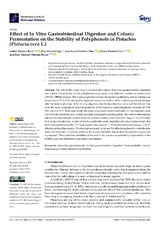Effect of In Vitro Gastrointestinal Digestion and Colonic Fermentation on the Stability of Polyphenols in Pistachio (Pistacia Vera L.)
Autor
Velasco-Ruiz, Isabel
Santiago, Elsy de
Ordóñez-Díaz, José Luis
Pereira-Caro, Gema
Moreno-Rojas, José Manuel
Editor
MDPIFecha
2023Materia
Pistachio(Poly)phenols
In-vitro gastrointestinal digestion
Bioaccessibility
Colonic fermentation
Human microbial metabolism
METS:
Mostrar el registro METSPREMIS:
Mostrar el registro PREMISMetadatos
Mostrar el registro completo del ítemResumen
The aim of this study was to evaluate the impact of in vitro gastrointestinal digestion and colonic fermentation on the polyphenol compounds from different varieties of pistachio by UHPLC-HRMS analysis. The total polyphenol content decreased significantly, mostly during oral (recoveries of 27 to 50%) and gastric digestion (recoveries of 10 to 18%), with no significant changes after the intestinal phase. After in vitro digestion, the hydroxybenzoic acids and the flavan-3-ols were the main compounds found in pistachio, with respective total polyphenol contents of 73 to 78% and 6 to 11%. More specifically, the main compounds determined after in vitro digestion were 3,4,5-trihydroxybenzoic acid, vanillic hexoside and epigallocatechin gallate. The colonic fermentation affected the total phenolic content of the six varieties studied, with a recovery range of 11 to 25% after 24 h of fecal incubation. A total of twelve catabolites were identified after fecal fermentation, the main compounds being the 3-(3′-hydroxyphenyl)propanoic, 3-(4′-hydroxyphenyl)propanoic, 3-(3′,4′-dihydroxyphenyl)propanoic, 3-hydroxyphenylacetic acids and 3,4-dihydroxyphenyl-ɣ-valerolactone. Based on these data, a catabolic pathway for colonic microbial degradation of phenolic compounds is proposed. The catabolites identified at the end of the process are potentially responsible for the health properties attributed to pistachio consumption.

